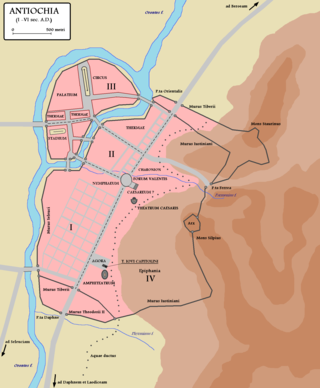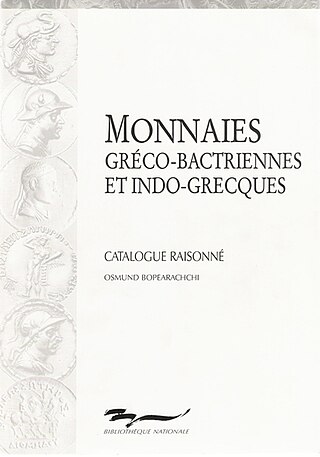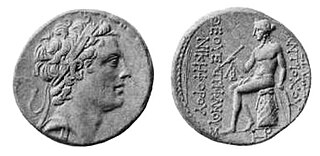Related Research Articles

Antioch on the Orontes was a Hellenistic Greek city founded by Seleucus I Nicator in 300 BC. It was one of the greatest and most important Greek cities of the Hellenistic period. The city served as the capital of the Greek Seleucid Empire and later as regional capital to both the Roman and Byzantine Empire. During the Crusades, Antioch served as the capital of the Principality of Antioch, one of four Crusader states that were founded in the Levant. The modern city of Antakya, in Hatay Province of Turkey, was named after the ancient city, which lies in ruins on the Orontes River and did not overlap in habitation with the modern city.

Demetrius III Theos Philopator Soter Philometor Euergetes Callinicus was a Hellenistic Seleucid monarch who reigned as the King of Syria between 96 and 87 BC. He was a son of Antiochus VIII and, most likely, his Egyptian wife Tryphaena. Demetrius III's early life was spent in a period of civil war between his father and his uncle Antiochus IX, which ended with the assassination of Antiochus VIII in 96 BC. After the death of their father, Demetrius III took control of Damascus while his brother Seleucus VI prepared for war against Antiochus IX, who occupied the Syrian capital Antioch.

Antiochus X Eusebes Philopator was a Seleucid monarch who reigned as King of Syria during the Hellenistic period between 95 BC and 92 BC or 89/88 BC. He was the son of Antiochus IX and perhaps his Egyptian wife Cleopatra IV. Eusebes lived during a period of general disintegration in Seleucid Syria, characterized by civil wars, foreign interference by Ptolemaic Egypt and incursions by the Parthians. Antiochus IX was killed in 95 BC at the hands of Seleucus VI, the son of his half-brother and rival Antiochus VIII. Antiochus X then went to the city of Aradus where he declared himself king. He avenged his father by defeating Seleucus VI, who was eventually killed.

Philip I Epiphanes Philadelphus was a Hellenistic Seleucid monarch who reigned as the king of Syria from 94 to either 83 or 75 BC. The son of Antiochus VIII and his wife Tryphaena, he spent his early life in a period of civil war between his father and his uncle Antiochus IX. The conflict ended with the assassination of Antiochus VIII; Antiochus IX took power in the Syrian capital Antioch, but soon fell in battle with Antiochus VIII's eldest son Seleucus VI.

Antiochus XI Epiphanes Philadelphus was a Seleucid monarch who reigned as King of Syria between 94 and 93 BC, during the Hellenistic period. He was the son of Antiochus VIII and his wife Tryphaena. Antiochus XI's early life was a time of constant civil war between his father and his uncle Antiochus IX. The conflict ended with the assassination of Antiochus VIII, followed by the establishment of Antiochus IX in Antioch, the capital of Syria. Antiochus VIII's eldest son Seleucus VI, in control of western Cilicia, marched against his uncle and had him killed, taking Antioch for himself, only to be expelled from it and driven to his death in 94 BC by Antiochus IX's son Antiochus X.
The Patriarch of Antioch is a traditional title held by the bishop of Antioch. As the traditional "overseer" of the first gentile Christian community, the position has been of prime importance in Pauline Christianity from its earliest period. This diocese is one of the few for which the names of its bishops from the apostolic beginnings have been preserved. Today five churches use the title of patriarch of Antioch: one Oriental Orthodox ; three Eastern Catholic ; and one Eastern Orthodox.

Bohemond III of Antioch, also known as Bohemond the Child or the Stammerer, was Prince of Antioch from 1163 to 1201. He was the elder son of Constance of Antioch and her first husband, Raymond of Poitiers. Bohemond ascended to the throne after the Antiochene noblemen dethroned his mother with the assistance of the lord of Armenian Cilicia, Thoros II. He fell into captivity in the Battle of Harim in 1164, but the victorious Nur ad-Din, atabeg of Aleppo released him to avoid coming into conflict with the Byzantine Empire. Bohemond went to Constantinople to pay homage to Manuel I Komnenos, who persuaded him to install a Greek Orthodox patriarch in Antioch. The Latin patriarch of Antioch, Aimery of Limoges, placed Antioch under interdict. Bohemond restored Aimery only after the Greek patriarch died during an earthquake in 1170.

Osmund Bopearachchi is a Sri Lankan historian and numismatist who has specialized notably standardized the coinage of the Indo-Greek and Greco-Bactrian kingdoms. He is currently Emeritus Director of the CNRS at the École normale supérieure and Adjunct Professor of Central and South Asian Art, Archaeology, and Numismatics, University of California, Berkeley.

The coinage of the Seleucid Empire is based on the coins of Alexander the Great, which in turn were based on Athenian coinage of the Attic weight. Many mints and different issues are defined, with mainly base and silver coinage being in abundance. A large concentration of mints existed in the Seleucid Syria, as the Mediterranean parts of the empire were more reliant on coinage in economic function.

The Numismatic Museumof Athens is one of the most important museums in Greece and it houses a collection of over 500,000 coins, medals, gems, weights, stamps and related artefacts from 1400BC to modern times. The collection constitutes one of the richest in the world, paralleled by those of the British Museum in London, the Bibliothèque Nationale in Paris, the State Hermitage Museum in St. Petersburg, the Bode Museum in Berlin, and the American Numismatic Society in New York. The museum itself is housed in the mansion of the archaeologist Heinrich Schliemann, formally known as Iliou Melathron.
Philip de Jersey is a Guernsey archaeologist and numismatist. He is known as an expert on Celtic coins of the Iron Age.
The Samir Shamma Prize for Islamic Numismatics is a bi-annual award for the best book or article in the field of Islamic Numismatics.

Barclay Vincent Head was a British numismatist and keeper of the Department of Coins and Medals at the British Museum.
Adada is an ancient city and archaeological site in ancient Pisidia, north of Selge and east of Kestros River, near the village of Sağrak, in Isparta Province’s Sütçüler township. The location was identified as Karabavullu or Karabavli, about 35 km south of Lake Eğirdir.
David Michael Metcalf was a British academic and numismatist. He was the director of the Heberden Coin Room of the Ashmolean Museum, a fellow of Wolfson College and Professor of Numismatics at the University of Oxford. He held the degrees of MA, DPhil and DLitt from Oxford.
Simon Bendall was an English numismatist, recognised as the leading authority on late Byzantine coins.
William E. Metcalf, FSA is an American numismatist, ancient historian, and former curator, who is an expert in the study of Roman coins. He is especially known for his pioneering work on Roman provincial coins and particularly the Roman cistophori of Asia Minor.

Haim Gitler is an Israeli curator and researcher, specializing in the field of numismatics. He is chief curator of archaeology and curator of numismatics at the Israel Museum, Jerusalem, as well as the President of the Israel Numismatic Society.
Carmen Arnold-Biucchi is a classical numismatist and archaeologist. Born in Lugano, Switzerland, she studied classical archaeology and ancient history at the University of Fribourg, Switzerland, receiving her Magister in 1971. She completed her dissertation on Cypriot terracottas in 1976. She is an expert on the coinages of Greek Sicily and Hellenistic numismatics.
References
- 1 2 3 "Collection: Dorothy B. Waage Collection | ArchivesSpace at Western Michigan University Libraries". aspace.library.wmich.edu. Retrieved 2022-11-22.
- 1 2 Butcher, Kevin (2004). Coinage in Roman Syria: Northern Syria, 64 BC-AD 253. Royal Numismatic Society. pp. 2, 362. ISBN 978-0-901405-58-6.
- ↑ "Frederick O. Waage | Britannica". www.britannica.com. Retrieved 2022-11-22.
- ↑ Broneer, Oscar (1950-01-01). "Antioch-on-the-Orontes IV, Part One, Ceramics and Islamic Coins. By Frederick O. Waagé". American Journal of Archaeology. 54 (1): 85–89. doi:10.2307/500648. ISSN 0002-9114. JSTOR 500648.
- ↑ Carson, R. a. G. (1954). "Antioch-on-the-Orontes, IV, Part 2. Greek, Roman, Byzantine and Crusaders' Coins. By Dorothy B. Waage. 13½ × 11. Pp. xii + 187. Princeton: Princeton University Press. London: Oxford University Press. The Hague: Martinus Nijhoff, 1953. 163s. 6d". The Antiquaries Journal. 34 (1–2): 92–93. doi:10.1017/S0003581500073388. ISSN 1758-5309. S2CID 161706867.
- 1 2 Jenkins, G. K. (1954). "Antioch-on-the-Orontes, IV, part 2: Greek, Roman, Byzantine and Crusaders' Coins. By Dorothy B. Waage. Princeton: University Press, 1952 (London: Oxford University Press). Pp. xii + 187, 8 pll. £8 2s. 6d". The Journal of Hellenic Studies. 74: 233. doi:10.2307/627648. ISSN 2041-4099. JSTOR 627648. S2CID 164052522.
- ↑ Metcalf, David Michael; Museum, Ashmolean (1995). Coinage of the Crusades and the Latin East in the Ashmolean Museum Oxford. Royal Numismatic Society. ISBN 978-1-85444-062-4.
- ↑ The Numismatic Chronicle. Royal Numismatic Society. 2001.
- ↑ Waage, Dorothy B. Antioch-on-the-Orontes. IV.: Part Two: Greek, Roman, Byzantine and Crusaders' Coins. University Press, 1952.
- ↑ Schindel, Nikolaus. "Zur Minimus-Prägung des Kaisers Anastasius I." Jahrbuch für Numismatik und Geldgeschichte 61 (2011): 109-130.
- ↑ Society, American Numismatic (1980). Museum Notes. American Numismatic Society.
- ↑ "Lehmann (Lotte) and Dorothy Waage correspondence collection". oac.cdlib.org. Retrieved 2022-11-22.